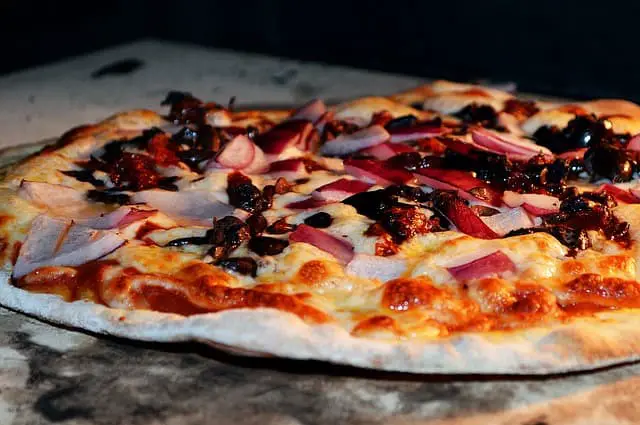This is an introduction into pizza stone basics. How to start using a new pizza stone for the first time. Along with more advanced tips and helpful information. Become a pizza stone master and avoid common mistakes that will hold your cooking back.
How to start using a new pizza stone for the first time?
- Check If Pizza Stone Needs To Be Washed First (Most Do Not)
- Place Stone In Cold Oven (Not Turned On)
- Preheat Oven To Desired Temperature
- Let Pizza Stone Heat Up
- Slide Pizza Onto Pizza Stone
- When Cooking Is Complete Remove Pizza With A Peel
- Clean If Any Toppings Fell Off Onto Stone
- Otherwise Leave Pizza Stone In Oven
Pizza stones are really fun to shop for and I would recommend checking out the best pizza stones on Amazon now!
Why Use a Pizza Stone?
In case you aren’t sure what is so great about a pizza stone. They are worth having if you make homemade pizzas frequently. Actually any pizza can be cooked on one, frozen pizzas will benefit greatly.
How To Make A Boring Frozen Pizza Better
The novelty is in the ability of the stone to absorb and retain heat. The air in a oven doesn’t hold heat as well as a stone or baking pan.
Stone vs Pan
The difference between using a pizza stone versus a baking pan? The stone will hold in heat for longer. A pans heat is lost when either taking it out or placing a cool (or frozen) pizza on top.
The stone will cook the crust of the pizza alone. As opposed to relying on just the heat of the oven. Which is lost when opening or closing the oven, or from the constant adjusting.
You want your crust to cook faster than the rest of the pizza. This is achieved through a pizza stone.
Making Frozen Pizza’s Without A Pan
Should You Season A Pizza Stone?
One misconception is that a pizza stone needs to be seasoned. The false way to season it would be to add oil to the stone. I am against this idea because it is unnecessary and could lead to other problems.
Unlike cast iron pans a pizza stone does not need to be seasoned. Seasoning comes from continuous use of the stone. As it will absorb pizza grease, cheese and oils.
If you want to condition a stone faster you can leave it in the oven. As opposed to cleaning it after every use.
Most manufactures will state that no seasoning is required.
Preheating A Pizza Stone
A very important part of using a pizza stone. Not to be confused with preheating your oven. After your oven has reached temperature. You should allow the stone to heat up after.
Because the stone may take a little bit longer than the initial oven preheating. Allow for extra time to get the stone up to temperature as well.
How Long To Preheat?
Each stone will vary on how long it should be preheated. Depending on how thick the stone is and where is located in the oven.
Obviously thicker and larger pizza stones will take a bit longer. Although most pizza stones do not vary in thickness by much. The thicker stones are up to 1” with 5/8” being the common size.
Generally you should preheat the stone for at least 30 minutes after oven has reached temperature. If you want to ensure it is hot enough then go for 50 minutes.
With the oven preheating and the stone inside it should not take longer that 50 minutes.
Placing the stone on the bottom rack or lowest in the oven will preheat it the fastest. You can use a infrared thermometer to measure the temperature of your stone to be precise.
How To Clean
Always allow your stone to cool before cleaning it. Pizza stones over time will look like they are dirty. The once clean stone surface will have black stains.
This is perfectly normal and should be expected. The only time you need to clean them is to remove excess buildup. This comes from cheese or possibly toppings that have crusted onto the stone top.
I recommend cleaning only when it is noticeably dirty or dough begins to stick and is hard to slide on and off.
The easiest way to clean them is to use a plastic spatula to scrap the surface. Then wipe with a wet cloth or paper towel. You can use warm or cold water. Just do not use any type of soap.
Never use dish or any type of soap for cleaning your pizza stone. As it can absorb the soap and ruin the stone. If water isn’t working well enough you can mix in baking soda.
A soft brush can be used as well. Again do not use any type of metal to scrap the stone. Do not put your pizza stone in a dishwasher.
How To Avoid Breaking
Pizza stones can crack and you will hear or see this when shopping for one. Usually it is from abuse and improper care.
The best way to avoid breaking your pizza stone is to follow these rules.
Never slice pizza or cut food on your pizza stone. So never use a pizza cutter or knife on the surface. As it can crack or damage the stone, repeated use will start to create grooves in the stone.
Never place cold or even room temperature stone into a hot oven or grill. When grilling with a pizza stone you should bring stone up to temperature. Same goes with a hot stone, never put a frozen pizza onto a hot pizza stone.
Sudden changes in temperature can cause a stone to break. You may get away with using frozen pizzas. Just to be safe try to thaw them out safely before baking.
Gently place stone onto oven racks. Repeated moving around the stone can weaken it over time. They are tougher than you may think, but are weaker than a steel or aluminum pan.
Never cook with a wet pizza stone. If you happen to wash your stone, allow it to dry completely before baking. Any moisture in the stone can cause it to break.
Pizza Stone Temperature
The ideal oven and stone temperature is 500 degrees F. This is for conventional ovens in most kitchens. A actual pizza oven should be much hotter, but you don’t need a pizza stone for them.
Between 400 and 500 degrees should be the temperature of your pizza stone. Anything hotter and you are risking breaking your stone. They do not handle really high temperatures very well.
How To Make A Pizza Stone Non Stick
One problem that can occur is the dough sticks to the pizza stone. This is most common with brand new stones. Over time as the stone gets broken in this will become less of a problem.
Placing flour on your pizza stone will not help the problem. As the flour will just burn before you can place the pizza. Starting with a well floured dough is a good start.
Some people will use the pizza peel as a surface to make their pizza. The only problem is that the dough can stick to the peel. Always flour any surface where you roll and spread your pizza dough.
If you use another surface and will transfer your pizza with a peel. You can still put flour or some cornmeal onto the peel first. This will prevent it from sticking to the peel.
You can use parchment paper on a pizza stone. The paper can withstand temperature up to 450 degrees F. Parchment paper will prevent the pizza from sticking to the stone. Allowing for the pizza to slide off the stone much easier.
Heritage pizza stones have a ceramic surface that is non-stick. The ceramic is easier to clean and also reinforces the stone.
What Is A Pizza Peel?
A pizza peel is a tool used for transferring breads and pizzas from the oven. They look like a shovel or a large spatula. They have large flat spades that can hold an entire pizza.
A pizza peel can be wooden or made of metal. Pizzas can be made on top of a peel. A least you can roll out the dough, place it onto the peel. Then top the pizza. Make sure to flour the peel blade first.
Using the peel properly is important. For placing the pizza onto your stone. You want to quickly yank the peel backwards. The pizza will fall quickly into place.
This works better than inching the pizza onto the stone. You don’t want the pizza to fall apart, but most of all you want the whole bottom to land on the stone evenly. This will allow it start to bake quickly and uniformly.
Removing the pizza is simply done by quickly sliding the peel underneath the crust. In one quick action you should be able to get under the pizza and lift it up slightly.
Can You Use Both Sides?
Most pizza stones do not have top or bottom. You can cook pizza on both sides. Ideally you should only use one surface for cooking.
You could switch between baking pizzas on one side and breads on the other.
Some pizza stones may have one side with a logo carved into the stone. Do not use this side for cooking.
My pizza stone has a ceramic layer on one side. This is the side that is used for cooking the pizza.
Should I Oil My Pizza Stone?
You do not need to oil a pizza stone before using. Pizza stones become seasoned as they are used. Oil will be absorbed into the porous stone and when heated will smoke.
Where Should A Pizza Stone Be Placed In The Oven?
Most instructions and pizza brands will say to use the bottom rack of oven. Although there isn’t really a strong reason for this.
Depending on the type of oven. Pizza stones can be placed in any level of oven rack. You may have to experiment to see what works best.
I find personally that with my oven, the bottom rack would crisp up pizza crusts better. Also the pizza stone I bought said to use the lowest rack. So I follow that rule with great results.
Another reason is I leave my stone in the oven at all times. So placing it on the bottom leaves room for other food that I wouldn’t cook on the lowest racks.
The idea is that the stone will heat faster when near the heating coils. Which for a lot of ovens are on the bottom.
If you find your crust is cooking too fast on the bottom. Move your stone up to the middle and test it out. You want to find the right balance in baking a pizza.
The crust needs to get done before the toppings start to overcook. But you also don’t want the crust to start to burn too fast.

